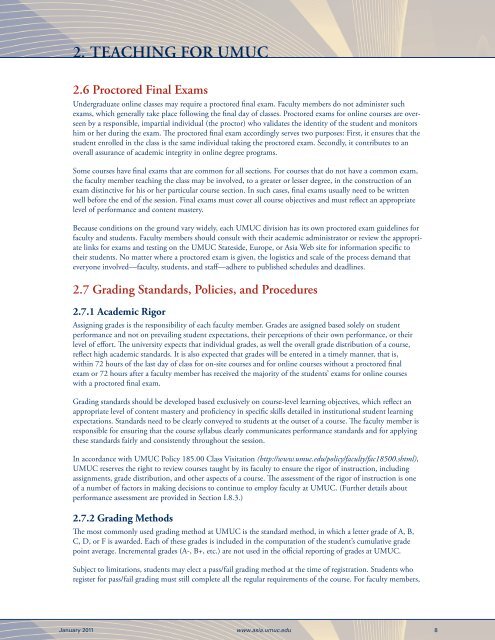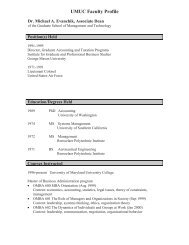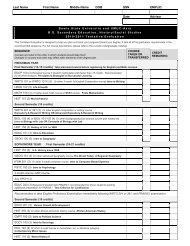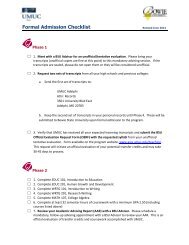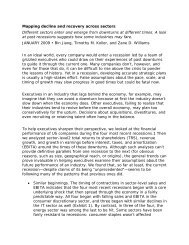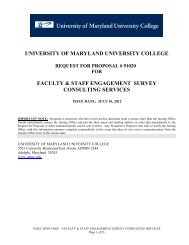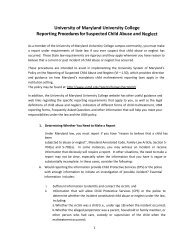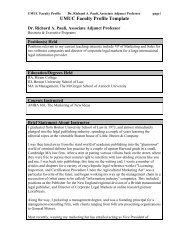Faculty Handbook_Asia_v5 BB.indd - University of Maryland ...
Faculty Handbook_Asia_v5 BB.indd - University of Maryland ...
Faculty Handbook_Asia_v5 BB.indd - University of Maryland ...
You also want an ePaper? Increase the reach of your titles
YUMPU automatically turns print PDFs into web optimized ePapers that Google loves.
2. TEACHING FOR UMUC2.6 Proctored Final ExamsUndergraduate online classes may require a proctored final exam. <strong>Faculty</strong> members do not administer suchexams, which generally take place following the final day <strong>of</strong> classes. Proctored exams for online courses are overseenby a responsible, impartial individual (the proctor) who validates the identity <strong>of</strong> the student and monitorshim or her during the exam. The proctored final exam accordingly serves two purposes: First, it ensures that thestudent enrolled in the class is the same individual taking the proctored exam. Secondly, it contributes to anoverall assurance <strong>of</strong> academic integrity in online degree programs.Some courses have final exams that are common for all sections. For courses that do not have a common exam,the faculty member teaching the class may be involved, to a greater or lesser degree, in the construction <strong>of</strong> anexam distinctive for his or her particular course section. In such cases, final exams usually need to be writtenwell before the end <strong>of</strong> the session. Final exams must cover all course objectives and must reflect an appropriatelevel <strong>of</strong> performance and content mastery.Because conditions on the ground vary widely, each UMUC division has its own proctored exam guidelines forfaculty and students. <strong>Faculty</strong> members should consult with their academic administrator or review the appropriatelinks for exams and testing on the UMUC Stateside, Europe, or <strong>Asia</strong> Web site for information specific totheir students. No matter where a proctored exam is given, the logistics and scale <strong>of</strong> the process demand thateveryone involved—faculty, students, and staff—adhere to published schedules and deadlines.2.7 Grading Standards, Policies, and Procedures2.7.1 Academic RigorAssigning grades is the responsibility <strong>of</strong> each faculty member. Grades are assigned based solely on studentperformance and not on prevailing student expectations, their perceptions <strong>of</strong> their own performance, or theirlevel <strong>of</strong> effort. The university expects that individual grades, as well the overall grade distribution <strong>of</strong> a course,reflect high academic standards. It is also expected that grades will be entered in a timely manner, that is,within 72 hours <strong>of</strong> the last day <strong>of</strong> class for on-site courses and for online courses without a proctored finalexam or 72 hours after a faculty member has received the majority <strong>of</strong> the students’ exams for online courseswith a proctored final exam.Grading standards should be developed based exclusively on course-level learning objectives, which reflect anappropriate level <strong>of</strong> content mastery and pr<strong>of</strong>iciency in specific skills detailed in institutional student learningexpectations. Standards need to be clearly conveyed to students at the outset <strong>of</strong> a course. The faculty member isresponsible for ensuring that the course syllabus clearly communicates performance standards and for applyingthese standards fairly and consistently throughout the session.In accordance with UMUC Policy 185.00 Class Visitation (http://www.umuc.edu/policy/faculty/fac18500.shtml),UMUC reserves the right to review courses taught by its faculty to ensure the rigor <strong>of</strong> instruction, includingassignments, grade distribution, and other aspects <strong>of</strong> a course. The assessment <strong>of</strong> the rigor <strong>of</strong> instruction is one<strong>of</strong> a number <strong>of</strong> factors in making decisions to continue to employ faculty at UMUC. (Further details aboutperformance assessment are provided in Section I.8.3.)2.7.2 Grading MethodsThe most commonly used grading method at UMUC is the standard method, in which a letter grade <strong>of</strong> A, B,C, D, or F is awarded. Each <strong>of</strong> these grades is included in the computation <strong>of</strong> the student’s cumulative gradepoint average. Incremental grades (A-, B+, etc.) are not used in the <strong>of</strong>ficial reporting <strong>of</strong> grades at UMUC.Subject to limitations, students may elect a pass/fail grading method at the time <strong>of</strong> registration. Students whoregister for pass/fail grading must still complete all the regular requirements <strong>of</strong> the course. For faculty members,January 2011 www.asia.umuc.edu 8


